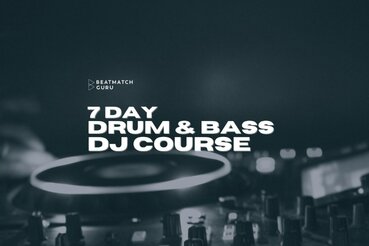
New to Drum & Bass DJing? Then you’re in the right place. In this article we’re running through 9 DJ tips for getting better at DJing Drum & Bass music.
Related Article: How to DJ Drum & Bass

Learn to DJ Drum & Bass.
1. Be picky about the tracks you collect
Digital DJing is unlike record vinyl DJing, the barrier to buying tracks is low, and downloading track legally or illegally is really easy.
Don’t let this clog up your DJ collection in your DJ software for example. Just be mega picky about the tracks that you download. It’s really important to keep a high quality music collection, get to know it well, so you can put together amazing DJ sets.
There’s no point having loads of tracks that take you ages to sift through the quality while mixing. Do the quality control before you add to your DJ music collection.
2. Set cue points for ‘sections’ of tracks that you like best
If you’ve not set cue points yet for some of your favourite tracks then it’s worth doing so.
An easy way to do this is by setting cue points in the introduction 32 or 64 beats apart, back from the drop. So this would cover the breakdown section (if there is one) and the introduction.
Pick cue points at various sections of the introduction to allow you to mix quickly or have a good amount of time to mix transition into the next song.
Cue points nearer the drop, you’re able to mix in a track quicker. Some tracks I’ve found you can set a cue point 8 beats before the drop, giving you the chance to quickly drop in a track really quickly.
3. Set cue points ready for double drops
A double drop is when the bassline of both tracks kicks in at the same time, meaning the first beat of both tracks hit the bassline at the same time after the build up.
Rule of thumb, set separate cue points at 16, 32, 64 and 128 beats backwards from the drop (first beat of the drop).
This will give you flexibility to line up your double drops at the beginning of your introductions and breakdowns.
This will give you flexibility to line up your double drops at the beginning of your introductions and breakdowns.
4. Build a DJ setlist when you’re buying music on Beatport
From experience I’ve found it quite helpful to build a setlist for a future mix when searching for new tracks on Beatport.
So I search for tracks, sift through ones I think are vibes and have the right energy that all fit together.
Listen again to all the tracks in the checkout cart of Beatport, then remove or keep the final tracks. Once I’m happy I will purchase and download all the tracks.
Then add the downloaded tracks into Rekordbox and order them to fit the energy transition of the setlist I want. Sometimes I do this by simply mixing the tracks getting to know the tracks a lot better, and then order them accordingly.
5. Listen out for the snare when beat matching
Drum & Bass beats are mad and complex sometimes, especially Jungle beats.
My best advice here if you’re struggling with beat matching by ear would be to list out for the snares. It’s a lot easier to listen out for two snares aligned or mis-aligned in the mix vs listening to kick drums that are lower frequencies.
6. Build energy in your DJ sets
I find that thinking about an energy curve of your DJ sets can really help you design your D&B setlists.
Using Mixed In Key can help you see the an energy rating for each of your tracks, which is great if you’ve planned out your sets energy curve.
A simple curve could be to start high energy, bring down the energy and the finish high. Or have a few up and down energy curves throughout your DJ set. Changing up the vibe throughout a DJ set from high energy grotty bangers, to deep rollers, Jungle rollers, vocal heavy anthems and back to grotty bangers is quite refreshing on the ears.
7. Practice DJing b2b with other D&B DJs
DJing back to back with other DJs is a really great way to pick up on other DJ skills and see how they transition between tracks and vibes.
You might even get to learn how to DJ on other equipment such as CDJs. Finally you’ll more than likely get exposed to new (or old) music you’ve never heard of before. Bonus!
8. Mix on a 4-channel mixer
DJ Drum and Bass to an advanced level will likely lead you to DJing on a three or four decks.
If you can get hold of a 4-channel DJ controller or DJ setup with three or four CDJs will give you a fantastic chance to DJ like the greats of D&B, such as Andy C, Friction, A.M.C and more.
Mixing with more than just two tracks is certainly a level up, so it’s certainly going to spice up your DJ sets with more creative mixing, more intensity and energy.
9. Be Unique
For starters, pick a great DJ name that is easy to say and that people will remember.
Stand out from the crowd by having a specific type of mixing that you’re synonymous with.
If you can, create a signature move or creative DJ move that no-one else, or not many people can do. For example, DJ Marky can scratch BUT scratch with the turntable upside down. I’ve not seen anyone else do that, which means I will always remember his, (his DJ name) for doing that.
